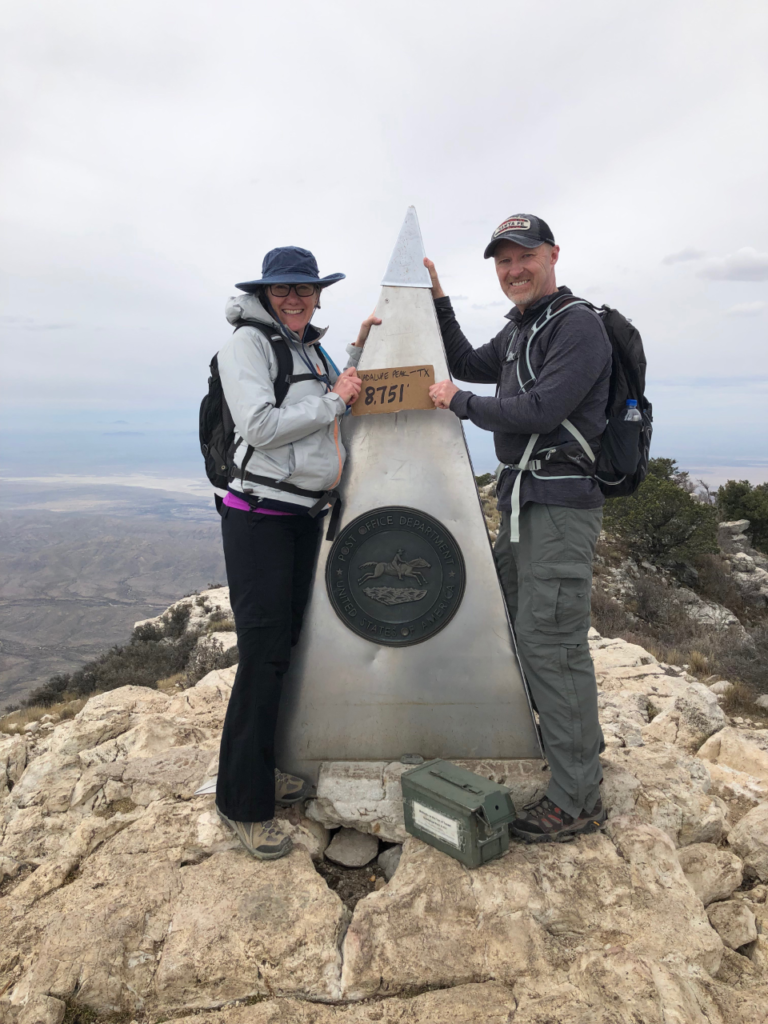West Texas Tour
Rae Ann Martin, Professor of Spanish, reflects upon her Spring Break trip through Texas.
4/1/2019
This Spring Break my husband and I had the opportunity to tour West Texas, a land we had not ventured into yet. We started in Van Horn, drove to the Guadalupe Mountains and took a day to hike up Guadalupe Peak, the highest natural point in Texas with an elevation of 8,751 feet. It was a 8.5 mile, 6 hour round trip hike up a gradual, treacherous, at times higher than others, incline. Once we reached the top of the mountain, the view was stunning and very worth the trip. However, not being in the best shape of my life, I crawled through Marfa, the next stop on the map, due to my sore muscles. The highlight of Marfa was the very serious wind storm that ran through on Tuesday evening. I thought we had some pretty prominent winds here in Dallas, but they do not compare. After a day in Marfa, we headed to Alpine, where we did a little bit of shopping and dined for lunch at the orignal Reata Restaurant (for those of you familiar with the Reata in Fort Worth).
In the evening, we headed to Ft. Davis, home of the McDonald Observatory, owned and operated by The University of Texas. With wind gusts up to 80 miles an hour, we were given the hybrid version of a Star Party, (a.k.a. star gazing). Fascinated and intrigued, I now have a whole new interest and curiosity in the Milky Way Galaxy and the galaxies beyond. We learned about and observed two visible galaxies, M81 and M82, located diagonally from the northeast star of the Big Dipper. With the help of a fancy telescope, they initially appear to be two blurry stars, but constitute actual galaxies that do not belong to the Milky Way. These galaxies and others will be better understood with the Giant Magellan Telescope, a more dignified and precise mechanism, than the ones housed at the McDonald Observatory, that is currently being constructed and should be fully completed by 2025. We will all have to travel to the Andes Mountains in Chile to encounter this magnificent addition to science. I look forward to that field trip with my students.
From the precious town of Alpine, we ventured to Marathon, a very quaint and hospitable place outside of Big Bend National Park, our final destination. This park covers over 800,000 acres of land and was the main reason we embarked on this West Texas Tour. We saved the best for last. Experiencing several climate changes and a variety of landscapes, we were able to spend a couple of days in the Park, hiking the Lost Mine Trail, eating in the middle of the Chisos Mountains, walking the Santa Elena Canyon of the Rio Grande, and ultimately fully admiring the natural beauty all around us. We could not get enough; it was absolutely stunning. We were amazed it was even part of the State of Texas. The Bluebonnets, in full bloom and up to my knees, covered the southern part of the park. Astonished by the sea of blue, I was unaware bluebonnets this tall even existed! After our adventurous exploration of Big Bend, on the last day we decided to make our way back to the hotel via Old Maverick Road. This very scenic but desert-like unpaved road, supposedly a shortcut, seemed like a good option at the time, but this 14 mile shortcut ended up taking an hour to travel. If you ever venture to Big Bend, which I highly recommend, avoid this road at all costs! Overall, we really enjoyed our time in West Texas and we look forward to one day returning.

